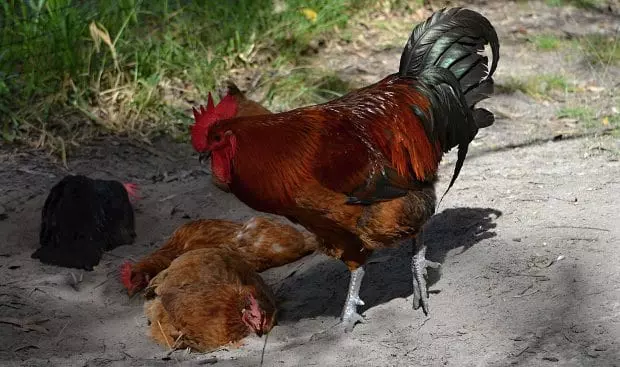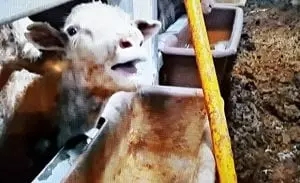Natural vs chemical control or both
I’m a big believer in using natural ways to help control mites and lice in chickens in conjunction with chemicals. What I mean by that is, providing the hens with a good, clean environment to live and forage whilst at the same time employing chemical methods to control parasites when needed.

Dust bathing area for chickens (image above)
Healthy, well-fed chickens kept in a clean environment away from wild birds and other animals tend to have less stress and fewer parasites. Here are some natural ways to greatly assist our poultry (especially chickens) against mites and lice infestations:
-
Change the coop mulch, nesting boxes, and bedding regularly – new fresh bedding regularly helps to stop a build-up of baddies.
-
Use steel and metal for housing instead of wood – this makes it harder for mites to hide and survive because unlike wood metal doesn’t have as many places to hide and breed. This especially includes perches and is why modern chicken tractors have alloy runs to roost on instead of wood. Keeping in mind chickens do prefer wood so I suppose it’s a compromise.
-
Feeding chickens garlic and onion – this alone is not a treatment for mites and lice (as some people think) and it may not even be a deterrent but it is possible a good diet and one with garlic or onion added occasionally could help to deter parasites. It can’t hurt anyway…
-
Keep the flock stress free – Try to ensure the birds feel safe and comfortable in their environment with good housing and protection. Strong birds deal better with parasites and may not be as much of a target (although to be honest health good or not as a way to protect birds could be a complete myth but again it doesn’t hurt to follow this rule).
-
Dust bathing areas – Chickens don’t just scratch they also dig. My chickens did bigger holes than my dog! Although chickens might scratch to look for food they also love to dig in order to help rid themselves of parasites. A hen will spend a great deal of time most days in a dust hole throwing dirt all over herself – the fine dust helps soothe skin irritations and may even kill mites and lice. Therefore, it’s important to provide a dust bathing area for chickens and this is easy enough but in pens where the ground is too hard or whatever a kiddies sand pit or raised bed with dry dirt or sand/dirt mix will work fine.
-
Water bath and the use of vinegar – Manually bathing a bird is not something commonly done nor is it usually required but if the bird is dirty (like poop around the vent) or requires a wash for any other medical reason, then a warm bath can be necessary. I don’t advocate the use of vinegar baths as a way to help control mites and lice because it can do more harm than good by stripping away the oil from the bird’s feathers. If more than warm water is needed then a mild soap can be used.

Hen throwing dust over herself (image above)
The totally organic way
We can all get wrapped around the axels and demand a totally organic way to treat our poultry for everything but unless you have a lot of time on your hands, just a few birds, or are extremely dedicated, going fully organic is unrealistic and quite possibly fruitless.
I’m not saying it’s totally impossible to rid your chickens of mites and lice through complete organic measures what I am saying is you need to employ several organic methods of external parasite control at the same time and conduct inspections with further treatments more often than chemical methods. This might not be a problem for some people, however, for others these time consuming and regular organic treatments for their hens could lead to less vigilance and a hassle put off for another day at the detriment of the flock.
That’s why, I’m an advocate for the use of easy and quick chemical control of external parasites on chickens and other poultry with the common sense approach to providing a good environment for the flock to live, feed, and play.
I see videos on YouTube proudly showing their “organic way” to control mites and lice such as spraying chickens with eucalyptus oil and hand washing the coop with soap but there’s little follow-up or evidence these methods work. It’s nice for the camera though…
Let me put it this way, if your child gets head lice do you shave his/her head to the scalp, submerge the head in apple cider vinegar and hope for the best, sit down with a fine comb hovering over the sink and sift the hair whilst squashing lice with the back of your fingernail; or, buy a lice and nit treatment from the chemist apply that and jobs done?
We go for the head lice treatment because it’s clinically proven, quick, easy, and most importantly it WORKS. Unfortunately, head lice treatments for humans are chemicals and we’d prefer not to use them, however, we know the likelihood of long-term damage from using it is very small.
Here’s another example, we live in a paralysis tick zone and we own a dog… Therefore, we have decided to give our pet a regular chemical tick treatment to ensure our dog doesn’t suffer a slow paralysis death by suffocation.
We could choose not to use a preventative chemical but instead check our dog daily for ticks and then remove them manually, but miss one tick and in 2 days our beloved pet could be dead – in fact, losing a dog to paralysis tick has happened to us and it was an awful experience.
Having said that, we are dealing with chickens and most people keep them for eggs and sometimes meat, therefore, we can’t be using chemicals on our birds which could pollute our own food supply and inadvertently harm us.
That’s why it’s important to follow withholding periods (if applicable) when using chemical treatments for mites and lice on backyard chickens. Also, it’s a given any chemical we do use to treat our birds must be used strictly as directed and if we do follow all the instructions properly the science and testing behind these products tell us they are safe.
Biological control of mites on chickens
There is one other emerging treatment for naturally controlling mites on chickens and that's through the biological use of predator mites. Although relatively new, the control of red poultry mite via the release of predatory mites into the coop shows promise as a natural and organic way to solve this issue.
The red poultry mite (or roost mite) can apparently be controlled through the release of a predatory mite species called Killer Mites Hypoaspis Aculeifer. These killer mites once released into the coop hunt and eat the parasitic red poultry mites and also their eggs.
Unfortunately, I have been unable to find any conclusive studies or detailed first hand experiences to show how effective the use of predatory mites actually is so again that's disappointing. Hopefully, the use of predatory mites to control red mites on chickens will prove to be a successful treatment in the future. In the meantime, I will certainly post an update if any further news about predatory mites becomes available.
Some commercial products for mite & lice control
For the last part of this article, I’m going to detail some commercial products I (or people I know) use on their chickens. Then, I will detail some of the popular treatments I don’t use and why.













